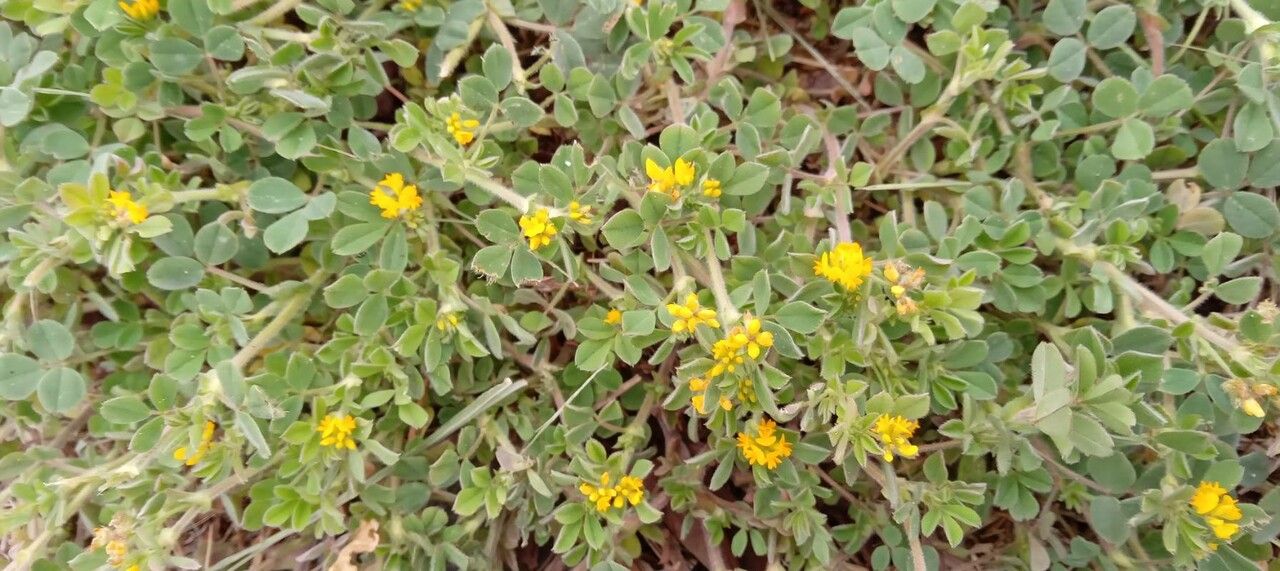Bur Clover
medicago minima
Also known as: ["Lesser Bur Clover","Small Bur Clover"]
Overview
A small annual legume with trifoliate leaves and small yellow flowers, producing bur-like seed pods.
Benefits & Perks
["drought tolerant","wildlife attractant (bees, butterflies, birds)"]
Botanical Classification
| Phylum: | Magnoliophyta |
| Class: | Magnoliopsida |
| Order: | Fabales |
| Family: | Fabaceae |
| Genus: | Medicago |
| Botanical Name: | Medicago minima |
Plant Characteristics
Basic Information
- Category: Herbs & Weeds
- Suitable Location: outdoor garden bed in full sun
- Suitable For:
- Is Weed: No
- Allergenicity: low
Environmental Needs
- Climate: {"temperatureRange":"0–40°C"}
- Hardiness: {"zones":"7–10"}
- Misting: rarely required, only if ambient humidity is very low
- Drainage: Fast-draining to prevent waterlogging.
- Soil Type: Well-draining loamy soil with added organic matter.
Maintenance Level
- Maintenance Level: very low
- Toughness Level: very high
- Pruning Frequency: As needed, typically after flowering or in early spring.
- Pruning Intensity: Light pruning; remove only dead or diseased parts.
Care Details
Ideal Sunlight Coverage:
Full sun (6–8 hours/day); tolerates partial shade in intense summer heat.
Sunlight Tolerance Tips:
Acclimate gradually to intense sunlight; protect from harsh afternoon sun in hot climates; adjust placement based on seasonal light changes.
Care Requirements
Care Difficulty
very easymoderate
Sunlight
full sun
Rotate plant for even light exposure; use sheer curtains to filter intense sun; avoid direct sun indoors.
Watering
every 7–10 days during active growth, reduce in winter
Water thoroughly but infrequently; ensure soil dries between waterings; avoid overwatering.
Soil
well-drained, sandy or loamy soil
pH: Slightly acidic to neutral (pH 6.0–7.0).
Use a mix of potting soil and coarse sand; avoid heavy clay soils; ensure pots have drainage holes.
Temperature
Prefers 60–85°F (15–29°C); tolerates mild frosts but avoids prolonged cold.
Monitor temperature extremes; adjust care seasonally; protect from sudden temperature shifts.
Fertilizing
every 4–6 weeks during growing season, none in winter
Fertilize only when actively growing; flush soil occasionally to prevent salt buildup; use organic options for gentle feeding.
Propagation
Methods
Seed propagation is most common; stem cuttings can also be used.
Step-by-Step Propagation Guide
- Prepare medium.
- Sow seeds or place cuttings.
- Maintain moisture.
- Provide warmth.
- Transplant once rooted.
Best Time: Spring or early summer when the plant is actively growing.
Environment
Warm (70–75°F), high humidity, and bright indirect light.
Medium
Well-draining seed starting mix or cactus mix with perlite.
Hormone
Optional for cuttings; not necessary for seeds.
Timeline
Seeds germinate in 1–3 weeks; cuttings root in 3–6 weeks.
Tools Needed
Seed trays, rooting hormone (optional), misting bottle, heat mat.
Quick Tips
Use fresh seeds for best germination; keep soil consistently moist but not waterlogged; provide bottom heat for faster germination.
Pruning & Repotting
Pruning Guide
Method
Snip back stems just above a leaf node or bud; avoid cutting into old wood.
Pruning Plan
Minimal pruning needed; focus on removing dead or damaged growth to maintain health.
Tools
Pruning shears, sterilizing solution.
Checklist
Sterilize tools; remove dead/damaged growth; shape lightly; clean up debris.
Repotting Guide
Best Season
Early spring before active growth begins.
Pot Size
Choose a pot one size larger with drainage holes.
Method
Remove plant gently; trim roots if necessary; repot in fresh, well-draining soil; water lightly.
Suggestions
Repot only when root-bound or soil is depleted; typically every 2–3 years.
Checklist
Check root condition; prepare new pot; use fresh soil; water after repotting.
Advanced Care Tips
Watering Mastery
Watering Checklist
Check soil moisture; water deeply; ensure drainage; adjust for season.
How to Apply Water Properly
Water at the base of the plant, ensuring moisture reaches the root zone; allow excess water to drain away; water in the morning to reduce evaporation.
Watering Schedule Tips
Water deeply once the top inch of soil is dry; reduce frequency in winter to prevent root rot.
Soil Improvement
Add perlite or sand for drainage; incorporate compost for fertility; ensure good aeration.
Temperature Stress Management
Signs of Temperature Issues
Wilting, yellowing leaves, stunted growth, or leaf drop.
Cold Stress
Slows growth, may cause leaf damage or dieback in freezing temperatures.
Solution: Provide frost protection; move indoors in cold climates; avoid wet soil in cold conditions.
Hot Stress
Leaf scorch, wilting, or reduced flowering in extreme heat.
Solution: Provide shade during peak heat; increase watering; improve air circulation.
Fertilizing Guide
Fertilizing Checklist
Check growth phase; dilute fertilizer; apply to soil; avoid foliage contact.
Fertilizing Method
Use balanced liquid fertilizer diluted to half strength every 4–6 weeks during growing season; avoid fertilizing in winter.
Common Problems & Solutions
Toxicity Warning
Cats
Non-toxicMedicago minima is not known to be toxic to cats. There are no reported cases of adverse effects in felines after ingestion of this plant.
⚡ Toxic If:
if eaten
Dogs
Non-toxicMedicago minima is not known to be toxic to dogs. There are no reported cases of adverse effects in canines after ingestion of this plant.
⚡ Toxic If:
if eaten
Humans
Non-toxicMedicago minima, commonly known as bur medick, is generally considered non-toxic to humans. It is not known to produce any significant toxic compounds that would cause adverse effects upon ingestion.
⚡ Toxic If:
if eaten
Frequently Asked Questions
Q: Is Medicago minima edible?
A: While it is not commonly consumed, the plant is not highly toxic and can be used as forage for livestock.
Q: Does Bur Clover attract wildlife?
A: Yes, it attracts bees, butterflies, and other pollinators due to its flowers.
Q: How does Medicago minima spread?
A: It spreads via its bur-like seed pods that cling to animals and clothing, facilitating dispersal.
Quick Reference
| Family: | Fabaceae |
| Care: | very easy |
| Light: | full sun |
| Water: | every 7–10 days during activ |
Get Expert Care Tips
Download the Plantious app for personalized care reminders and plant identification!
Google Play App Store








